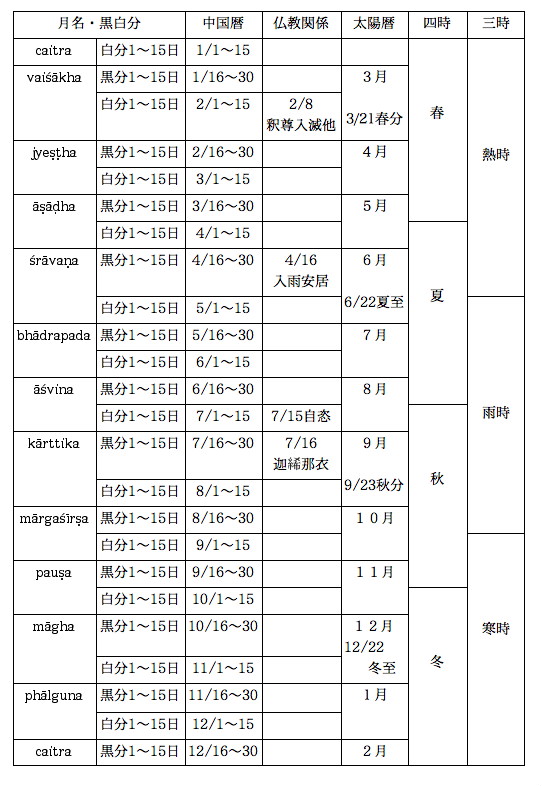
1. Introduction
2. The calendar
3. The Indian and Chinese calendars - the beginning and end of the year
 |
early Buddhism, Indian calendar, Chinese calendar, the calendar, vesākhā month, names of months, bright phase, dark phase, lunisolar calendar, intercalary month, rainy season retreat, pavāraṇā |

Through our research we want to create a chronological table recording the acts of the Buddha and his disciples and the formative history of the Saṃgha. In order to do so, it is necessary to clarify what kind of calendars were used during the Buddha's lifetime and in the Buddhist literature. In broad terms, the early Buddhist scriptures can be divided into those written in Pali and those in Chinese translation. Since the Indian and Chinese calendars are of course different, we have to be able to explain the corresponding relationship between them.
This essay aims to elucidate these points, but there are still many things that remain unclear. At any rate, we have reached the following conclusions, upon which we have based the construction of our chronological table.
(1) It is widely known that a lunisolar calendar has been used in India since ancient times. The Buddhist scriptures also observed this calendar.
(2) The names of the months are based on the asterism that the full moon falls into. (The Pali names are given first, with the Sankrit names in brackets.)
Citta (Caitra)
Vesākhā (Vaiśākha, Viśākhā)
Jeṭṭha (Jyeṣṭha, Jyaiṣṭha)
Āsāḷhā , Āsāḷhī (Āṣāḍha)
Sāvana (Śrāvaṇa)
Bhaddara (Bhādrapada, Bhādra)
Assayuja (Āśvina)
Kattika (Kārttika)
Maggasira (Mārgaśīrṣa)
Phussa (Pauṣa)
Māgha (Māgha)
Phagguṇa (Phālguna)
(3) The month is divided into the dark phase (the half month of the waning of the moon, from the day after full moon to the new moon) and the bright phase (the half month of the waxing of the moon, from the day after the new moon to the full moon). In a short month, the dark phase is fourteen days, but the bright phase is always fifteen days.
(4) In India, two systems are used: (a) where the bright phase is placed in the first half of the month and the dark phase in the second half, and (b) where the dark phase is placed in the first half of the month and the bright phase in the second half. Thus under the former system, the month ends on the day of the new moon and the full moon comes in the middle of the month, and under the latter system, the month ends at the full moon. In Buddhist literature, the latter system appears to have been used.
(5) According to Indian tradition, it appears to be most common that the year begins at the bright phase of the Citta (Caitra) month and ends at the dark phase of that month.
(6) We have constructed a comparative chart between the Indian and ancient Chinese calendars based on these points. It shows the main Buddhist festivals and events in relation to the solar calendar with errors according to the precession of the equinoxes corrected.

(7) Within the Buddhist Saṃgha it was usual to calculate age according to the religious age of the monk or nun. Here, one year lasts from the day after the pavāraṇā ceremony at the end of the rainy season retreat, and finishes on the day of that ceremony.



